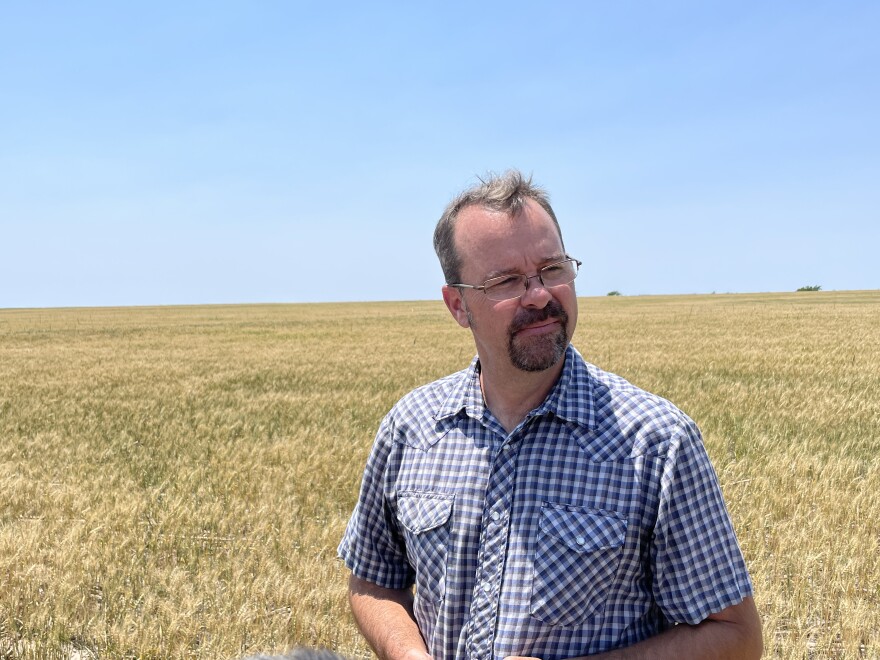Usually, Kansas is known for its fields of waist high, golden wheat. But this year blistering conditions have scorched some of the crop into short, patchy straw.
Standing in one of his fields near Norton in northwest Kansas, farmer Chris Tanner wonders if it’ll even make it through harvest.
“There’s going to be nothing in this,” Tanner said as he held a wheat stalk. “It’ll blow out the back of the combine. You can see the seeds kind of exposed there, it’ll shatter out even before we get here.”

It’s fields like these that have led industry groups to predict a 100 million bushel drop in Kansas’ wheat harvest this year. That’s a 30% cut from last year’s crop, in one of the country’s top wheat producing states.
The drop means farmers won’t contribute as much to grain supplies, which have been low since Russia invaded Ukraine and blocked wheat exports. The growers may also miss out on historic prices.
Drought is also wiping out fields beyond Kansas – in Oklahoma, experts say the harvest will be down by almost half and Nebraska’s crop is also expected to decline. More than 70% of the region is at least abnormally dry, according to the U.S. Drought Monitor. Much of the region has been behind on rainfall since about September.
Amanda Easterly, a researcher and extension agent with the University of Nebraska-Lincoln, said wheat farmers have faced drought, hail and fungal diseases this growing season.
“I’ve heard of a number of farmers who have had a good chunk of their fields zeroed out by the insurance adjusters,” she said. “It’s patchy in some places, but I don’t think anyone’s fully escaped everything.”

Joseph Glauber with the International Food Policy Research Institute said the challenging conditions are coming at a particularly bad time. The world’s been low on wheat since Russia cut off Ukrainian grain exports this spring.
“Wheat was tight to begin with, then Ukraine has anywhere from five to seven million tons of last year’s crop that’s stuck inside the country,” Glauber said. “So you look at the wheat market and you think, who can make up this grain?”
The tightening market has pushed wheat’s price tag up more than 50% this year. With drought cutting back Great Plains production this year, those prices could go even higher — eventually affecting the cost of things like bread, flour and pasta.
“We're going to have the smallest hard red winter wheat crop since 1963,” said Bill Lapp, an agricultural economist in Omaha. “It's made a bad situation worse. And, you know, the cure for high prices, of course, is high prices.”
The cost increases will be more painful in places like Egypt and Yemen, Lapp said. Those countries rely heavily on imports and lost a major source of wheat when Russia choked out Ukrainian exports.
Adding it up
The dry conditions in the Great Plains mean wheat farmers might miss out on historically high prices.
“You have to actually raise the crop before getting those high prices,” Tanner said. “And we’re in the middle of a drought that can push you into the hole.”
While the war in Ukraine pushed the price of wheat up, it also contributed to higher fertilizer and fuel prices, making it more expensive to grow crops in the U.S.
Tanner is able to quickly calculate what he pays for rent, fertilizer, herbicide and harvest costs; for a total of about $220 per acre. This season he expects to get less than half the wheat harvest he usually would. So even if wheat sells for a near-record $11 a bushel, Tanner said he’ll likely lose money on some of his fields.
“Prices are good,” he said. “But if you don’t have anything to sell it doesn’t really matter what the prices are.”
Scientists predict harsher growing seasons could become more common for Great Plains farmers as climate change contributes to extreme weather events and higher temperatures.
That’s why Tanner said this year’s challenging conditions and low harvest underscore his commitment to soil management practices like fallowing and crop rotations. He said those investments can help optimize even the driest conditions, by allowing the soil to rest, recover organic material and eventually produce higher yields.

“You start chasing markets and you wind up with problems. You have to tend to your soil and agronomy and play the long game,” Tanner said. “Uncovering soil and not protecting it is the nail in the coffin of productivity.”
In the short term, it’s hard for Tanner and other farmers who know they likely won’t be able to meet the demand for wheat this year.
“The world is in desperate need of wheat, and we want to do as best of a job as we can to feed them,” Tanner said. “But we can only do what Mother Nature's allowing right now.”
Follow Elizabeth on Twitter: @Ekrembert
Nebraska Public Media’s Tanner Dykstra contributed reporting to this story.
This story was produced in partnership with Harvest Public Media, a collaboration of public media newsrooms in the Midwest. It reports on food systems, agriculture and rural issues. Follow Harvest on Twitter: @HarvestPM
Copyright 2022 KCUR 89.3. To see more, visit KCUR 89.3.

